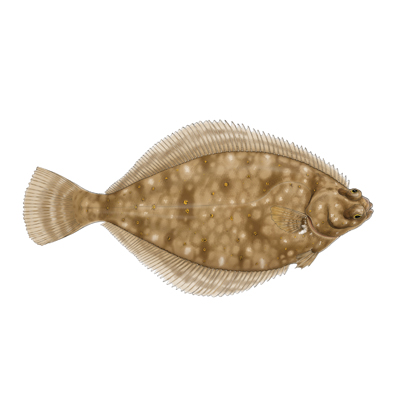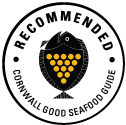

A smaller cousin of plaice and flounder, dab is a versatile and delicious fish that is currently under-rated.
Dab are a relatively abundant species of flatfish which provide a more sustainable alternative to more vulnerable, longer-lived and overfished species of flatfish such as plaice. It is mostly taken as bycatch in trawl fisheries and often discarded because of its low market value. Stock levels of dab are poorly understood in our area but there is little evidence that the stocks are unhealthy. Catches of dab landed in Cornwall have fluctuated between five and twenty tonnes per year since the 1990's.
In 2021 a total of 7 tonnes of dab were landed to Cornish ports with a value of £2.5k (MMO data).
Updated July 2023

Cornish vessels landing to Cornish ports
Demersal trawls are large nets that are pulled through the water with the bottom edge of the net touching the seabed. At each edge the net is pulled open by metal ‘trawl doors’. Sometimes referred to as Otter trawling.
Learn moreCornish vessels landing to Cornish Ports
Beam trawls are nets attached to a steel beam that holds the net open. The belly of the net is made of chains and the upper surface of the net is mesh. Beam trawlers pull two nets along the seabed simultaneously.
Learn moreCornwall Good Seafood Guide rates fish on sustainability using a scale of 1 to 5.
1, 2 and 3 are recommended, Fish to avoid are rated 5.
We use the system devised by the Marine Conservation Society (MCS) so our scores are comparable with the scores produced by MCS for the UK and fisheries from all around the world. For more information on scoring click here.
Dab is a right-eyed flatfish (both eyes are on the right side of the body) related to the plaice, flounder and sole. It can reach a length of about 40cms and an age of 10-12 years. Spawns in January to May in Cornish waters and is common in Cornish waters. Males become sexually mature at 2-3 years when 10-20cms long, the females at 3-5 years when 20-25cms. Biological vulnerability rating is moderatew 40% (Cheung et al 2005 source www.fishbase.org).
http://www.seafish.org/rass/index.php/profiles/dab-in-the-celtic-sea-and-west-of-scotland/In Cornish waters dab are landed by demersal trawls and beam trawls. Demersal otter trawling is often associated with discarding of unwanted fish, i.e. undersized and/or non-quota and/or over-quota species. Dab catches are generally discarded based on the availability of target species and market price, dab has a low commercial value. However the limited survival data available suggests that dab have a high survival rate (77-88% depending on trawl duration and processing time). There is no minimum landing size specified for dab in EU waters, therefore there is potential for landing of immature fish. In the Cornwall and North Western & North Wales Sea Fisheries Districts, landing dab below 15cm is prohibited.






Cornwall Good Seafood Guide is underpinned by the Marine Conservation Society (MCS) Good Fish Guide. The first UK consumer guide to sustainable seafood. For more information visit www.fishonline.org
Cornwall Good Seafood Guide is here to help us all make sustainable seafood choices. Choices that will help us keep the oceans healthy and Cornish fishers' futures safe. This website is funded by Cornwall Wildlife Trust. If you would like to make a meaningful difference to the health of our oceans, please consider making a donation to the Cornwall Wildlife Trust Ocean Emergency fund. Your donation will help safeguard these remarkable environments, ensuring that they continue to thrive for generations to come. Together, we can be stewards of the seas and champions for a healthier, more sustainable future.